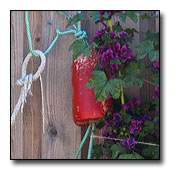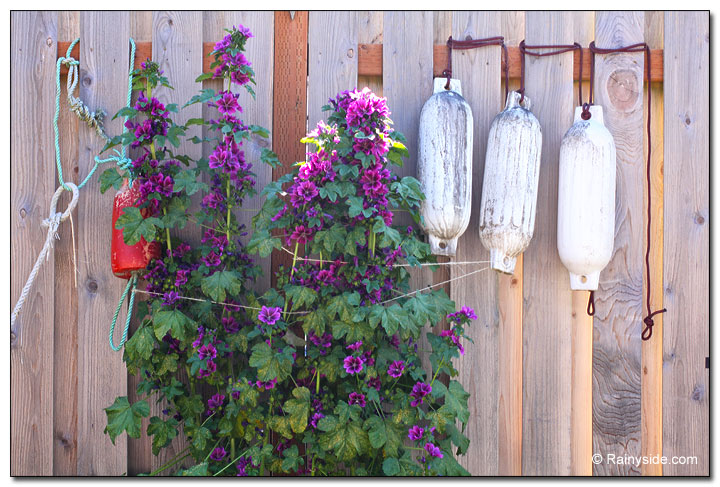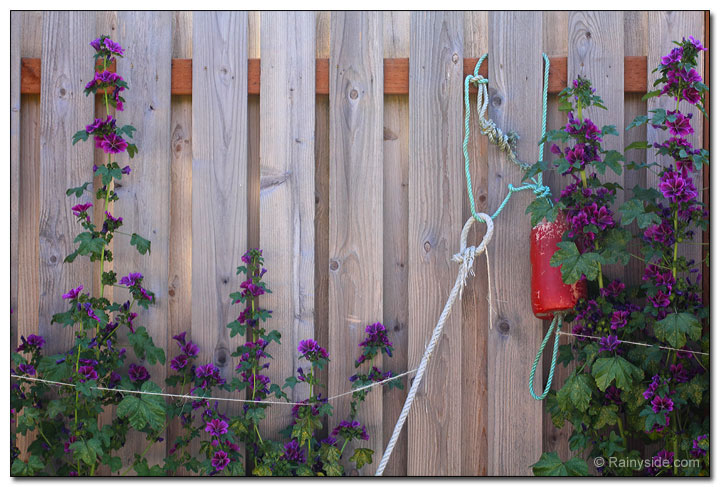Malva sylvestris 'Windsor Castle'
WOODS MALLOW, CHEESES
Family: Malvaceae.
Pronounced: MAL-vuh sil-VESS-triss

Quick Jumps
Growing Guide
Rainy Side Notes
GROWING GUIDE

Origin:
Garden.
Plant Group:
Perennial.
Hardiness:
Sunset zones: All zones.
USDA zones: 5-8.
Mature size:
Height: 36-48 inches (1-1.2 m).
Flowering period:
Summer into fall.
Flowering attributes:
Two inches wide (5 cm), purple with dark purple veining.
Leaf attributes:
Palmately lobed, hairy, green leaves.
Growth habit:
Erect growth.
Light:
Full sun to partial shade.
Soil:
Moist, but well-drained, average soil.
Propagation Methods:
Sow in situ early spring to early summer.
Root basal cuttings in spring.
Pests and Diseases:
Rust and Cercospora leaf spot are problematic.
Rainy Side Notes

The sitting down, when school was o'er
Upon the threshold of the door
Picking from Mallows, sport to please
The crumpled seed we call'd a cheese.
A hollyhock (Alcea) relative, Malva sylvestris is a short-lived perennial often grown as a biennial or an annual. They look great in cottage gardens, yet most likely are not good candidates for the too-tidy-for-spit garden. The plants are stockier than hollyhocks; however, the plants need staking or they tend to flop over. During Music in the Gardens Tour 2015 on the Long Beach Peninsula, I visited Marla McGrew’s Ocean Park garden. I liked her clever solution for keeping a fencerow of them upright. She hangs a bit of seaside charm on her fence with rope and buoys, then uses twine to keep her mallows upright — a charming entrance to her space she calls the Real Living Garden.
Cultivars
- M. f. alba
- ‘Bibor Fehlor’
- ‘Brave Heart’
- 'Cottenham Blue’
- ‘Mauritiana'
- ‘Mystic Merlin’
- ‘Primley Blue’
- ‘Tournai’
- ‘Windsor Castle’
- ‘Zebrina’
Malvas begin blooming in summer, and give a long season of flowers. When I originally wrote this growing guide in November 2007, I could see the plants still in bloom and they continued to flower until the first hard frost hit. Malvas reseed themselves, but I haven’t found them to be too troublesome in their seeding habits, just mildly annoying at times.
“The common mallow, Malva sylvestris, is a frequent weed in gardens, which hired labour or unpaid friends, wishing to help with the weeding, will always leave untouched, because, with its mound of dark green, rounded leaves, it looks important,” wrote Christopher Lloyd. He thought the species had a few good variants, and noted ‘Primley Blue’ as one of the better ones.
Throughout our history, Malvas have long been cultivated for medicinal, religious, and culinary purposes. The unripe seed often called cheeses was widely available and a common source of food for the poor.
As with hollyhocks, Malvas suffer from rust on their leaves here in the maritime Northwest. If you want to grow them and don’t wish to spray fungicides, you learn to live with the disfigured leaves or you defoliate your plants to keep the rust at bay. They are a tough plant to grow to perfection. Me? When they reseed in the garden, I overlook the rust covered leaves and enjoy the charming flowers.


Gardening for the Homebrewer: Grow and Process Plants for Making Beer, Wine, Gruit, Cider, Perry, and More
By co-authors Debbie Teashon (Rainy Side Gardeners) and Wendy Tweton
Copyright Notice | Home | Search | Perennials

